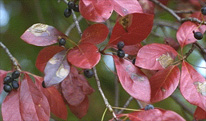Cleaning Gutters!
The first thing you need to decide is how you're going to collect the leaves and other matter you remove from the gutters. When gutter contents are a bit damp, you can either use what I call the "scoop and drop" method or the "gutter bucket" method. For the gutter bucket method damp leaves allow a more dense packing of the bucket, and for the scoop and drop method, it stops the leaves from fluttering all over when you drop them. (The least messy way to clean gutters is when the gutter contents are dry and that method is discussed in the next section).
The scoop and drop method is when you scoop out the gutter and drop the contents to the ground onto a plastic tarp or drop cloth. This method is fastest and all you have to do is move the plastic tarp along with you as you move the ladder. When it gets full, just dump the leaves into your compost or trash bag.
The gutter bucket method is fairly common and involves taking a plastic bucket with a metal handle, cutting the handle in two at the center. Then bend the ends of the handle halves into hook shapes that you then hook onto the edge of the gutter. You simply scoop out the gutter and empty it into the bucket. Be ready to do a lot of up and down on the ladder though with this method since that bucket gets filled up quickly.
When you have dry gutter contents a better way to clean out and collect the dried leaves and sticks is what I call the "gutter bag" method.
With the gutter bag method you take a plastic bucket and fasten the handles similar to what we did in the gutter bucket method in the previous section. But here, you will cut off the bottom of the bucket creating a bottomless bucket.
Now, take a trash bag and fasten it around the bucket just under the metal handle. You can fasten it tightly with a large rubber band, or duct tape or a large Velcro strap. Now you can easily empty the dry contents into the plastic bag with the bucket serving as a form and throat for the bag. The reason this works well is that the leaves are dry so they are light, but bulky.
Make sure you don't fill the bag too full (heavy). Use your judgment with safety in mind when on the ladder.
With your method of leaf collection established from the previous two sections, it's now time for the fun part. Cleaning the gutters!
You can use any number of things to scoop the contents out of a gutter. You can fabricate your own scooper from a plastic jug with a handle but assuming you're not into making your own tools, you can just use a trowel or garden spade. You can even use old kitchen tools like a spatula.
If you need our services contact us at www.arbor-life.com








 Following pollination, greenish flowers appearing in late spring develop into purple berries. It prefers moist soils and is
Following pollination, greenish flowers appearing in late spring develop into purple berries. It prefers moist soils and is

